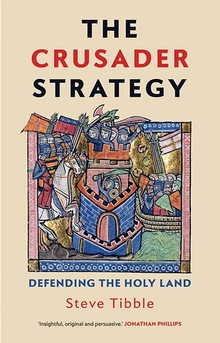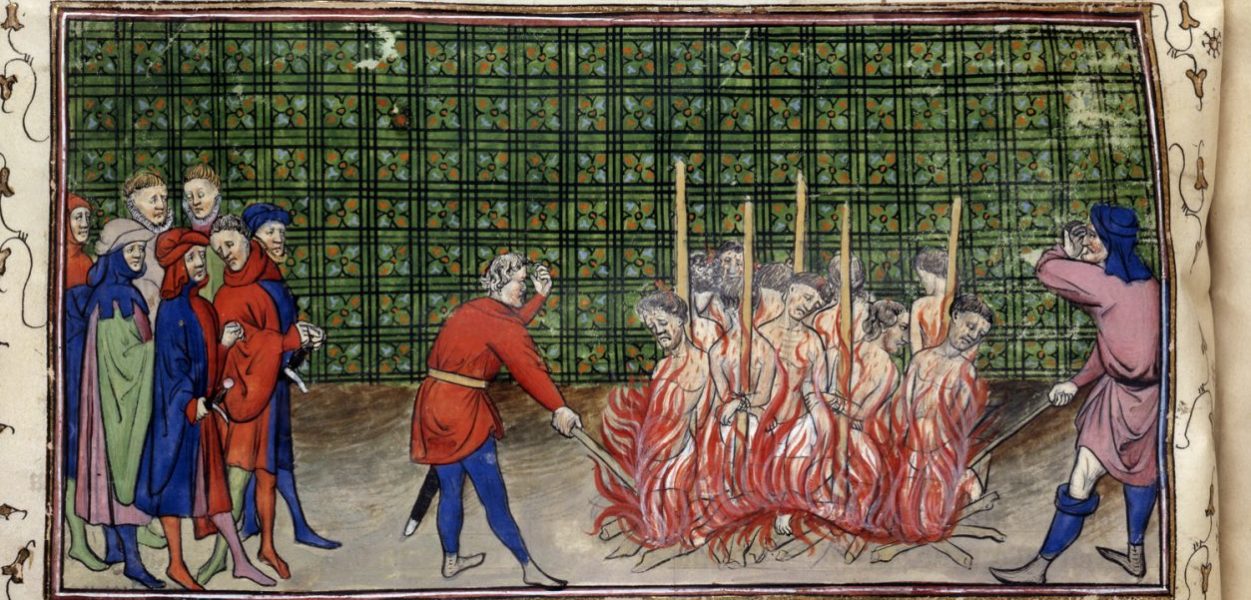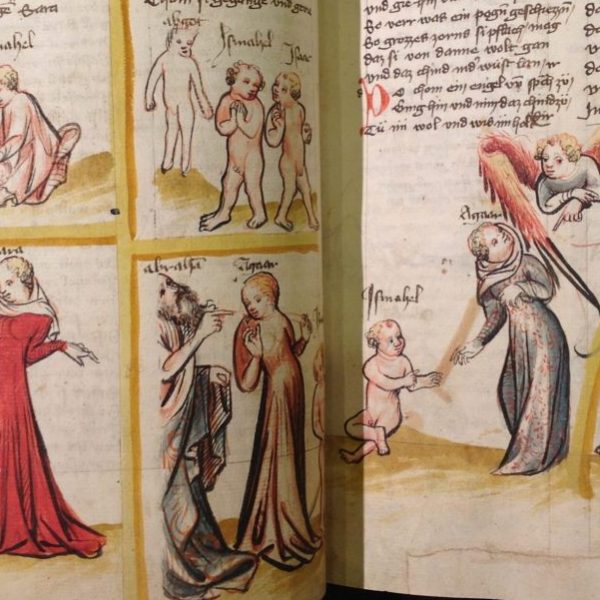Medieval Strategy? The Great “Leper Conspiracy” of 1321
Steve Tibble—
Researching the development of the crusader states helped me appreciate the sensitive and sophisticated nature of medieval strategy. But it also demonstrated how extraordinarily disappointing human beings could be—and still are, of course.
At the end of the crusades, the Templars were suppressed by King Philip the Fair. They were accused of outlandish, unbelievable conspiracies, and their huge wealth was confiscated.
I was intrigued by this. On one level, it was all very clear. The French crown were in need of ready cash, so they had cynically invented outrageous, entirely spurious charges and used them as a pretext to plunder the riches of the Templars. So far, so obvious.
But what if that was not the whole truth? What if the king had really believed the mad accusations and conspiracy theories that he and his advisors were throwing around? And what if the French monarchy had made a habit of such behavior?
One of Philip the Fair’s successors, for instance, plumbed similarly strange depths soon afterwards. Philip V (1316—1322) and his advisors genuinely believed that there was a plot by lepers—obviously—to poison wells across France. This supposed conspiracy was—again, obviously—organized and funded by Jews.
Life as a leper in the Middle Ages was pretty tough. You would think it could not get much worse. Except that it could. And in 1321 it did.
Bernard Gui (the Inquisitor at Toulouse), who was present at the “questioning” of many lepers, wrote,
there was detected and prevented an evil plan of the lepers against the healthy persons in the kingdom of France. Indeed, plotting against the safety of the people, these persons, unhealthy in body and insane in mind, had arranged to infect the waters of the rivers and fountains and wells everywhere, by placing poison and infected matter in them and by mixing [into the water] prepared powders, so that healthy men drinking from them or using the water thus infected, would become lepers, or die, or almost die, and thus the number of the lepers would be increased and the healthy decreased.
The extent of the psychological gymnastics involved in trying to explain the motives of these leper-terrorists, or even to invent the plot as a whole, was extraordinary: the best the crown could come up with, in their bleakly unimaginative way, was to suggest that the lepers wanted higher status, a bigger house, a better job-title, just like everyone else—“they aspired to the lordship of towns and castles,” wrote the cheery Bernard, “and had already divided among themselves the lordship of places, and given themselves the name of potentate, count or baron in various lands, if what they planned should come about.”
As with the suppression of the Templars, the response of the French crown to the new “conspiracy” was to deploy the full range of powers at the disposal of the state. By the middle of May 1321 many lepers had been tortured into giving detailed and imaginative “confessions”—and were then burnt.
King Philip V was, like his father, extremely superstitious anyway, and needed little additional incentive to draw ever more mad conclusions from the febrile investigations of his minions. On June 21, lepers all across France were rounded up and arrested.
The penalties inflicted on them were harsh in the extreme. All lepers were to be tortured and, once they had confessed, they were to be burnt. Pregnant lepers—the mind boggles—were allowed to give birth but, after the baby was able “to live and feed without their help,” they too were burned. In the unlikely event that torture failed to produce a satisfactory confession, the few survivors were sentenced to life imprisonment.
Interestingly, as in the case of the trial of the Templars, superstition, credulity, and sadism were combined with greed. And, of course, these were not mutually exclusive motivations. On the contrary, they all merged together very easily. The lepers did not have much, but it was decided that what few assets they had should be confiscated “and placed and held in [the king’s] hand.”
But there were other profitable opportunities to be seized, and other, more wealthy, minorities to be looked into. By the middle of June, victims of torture had begun to incriminate the other “usual suspects” of medieval society. The new targets were mainly Jews. Under torture—of course, always under torture—one leper was encouraged to say that a rich Jew had given him money to place powdered poisons into public water supplies.
The king did not specifically include the Jews in the crackdown at this stage, but local people, many of whom owed them money, were keen to get them involved. Regional chronicles noted that the terrorist plot “was done by the encouragement and the incitement of the Jews.” Perhaps not surprisingly, given the madness sweeping across France, “the Jews in some parts were burnt indiscriminately and especially in Aquitaine.”
Perhaps appropriately—and why not, all the other hated minorities were being blamed—lepers were also prompted to incriminate Muslims in the terrorist outrage. These accusations posed some practical problems, however, even for the most devoted of Philip’s servants—there was the minor detail that there were no Muslims living in France at that time. The Islamic net therefore had to be cast a little wider. The “king of [Muslim] Granada and the Sultan of Egypt” were said, even more implausibly than the other accusations, to be fronting the plot.
Finally, and for good measure, the good, old-fashioned specter of witchcraft was also raised. The lepers, despite being Christians, were accused of Satanic heresies. One tortured prisoner told his inquisitors that at the next “leper-meeting,” they were all going to “spit on the cross of Christ and upon his body, and also that the body of the Lord and his cross should be trampled underfoot.”
All the elements of the Templar trial were there, and they made a powerful cocktail—Jews and Muslims, terrorists and heretics, fear and jealousy, hysteria and calculation, superstition and greed. It was a winning formula, rolled out for the profit of the king and the applause of the crowd.
How did this deranged fiasco ever happen? It should go without saying that the entire plot was fabricated, or imagined, or both—this multiple pogrom took place without a single person having died of poisoning from the public water supply.
The Jews, as the traditional medieval victims, were an obvious target. In fact, the lepers seem to have had little connection with the Jews, either in reality (of course) or even in the folklore of prejudice that predated the mad outburst of 1321. But the lepers were feared and segregated because of their condition. And the costs of supporting them provided a financial reason why local communities might feel they were better off without them.
These mad outbursts were clearly a function of a society on edge and ill-at-ease with itself. And, perhaps a warning for our own times of pandemic, the bloodthirsty hysteria of 1321 was just a taster for what was to come—the horrific pogroms that followed the Black Death. When bad things happened, someone had to have sinned and somebody had to pay.
Medieval societies were certainly capable of strategy and planning—far more so, in fact, than we often give them credit for. But they were also capable of the opposite—using superstition, greed, and hysteria to achieve their goals.
And, lest we get too complacent, we do not have to look too far back in our own history to see the same sad formulae still being played out.
You can find Part One of this two-part series here.
Steve Tibble graduated from Cambridge and London Universities and is honorary research associate at Royal Holloway, University of London. He is the author of Monarchy and Lordships in the Latin Kingdom of Jerusalem, 1099–1291 and The Crusader Armies, 1099–1187.
Further Reading:



























